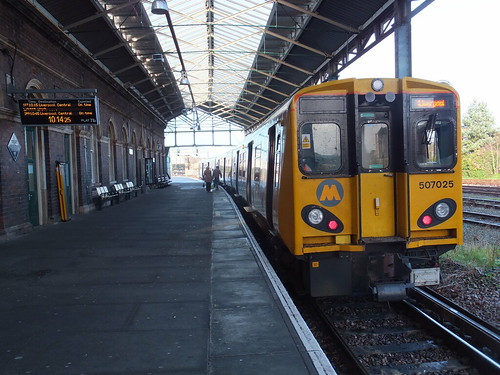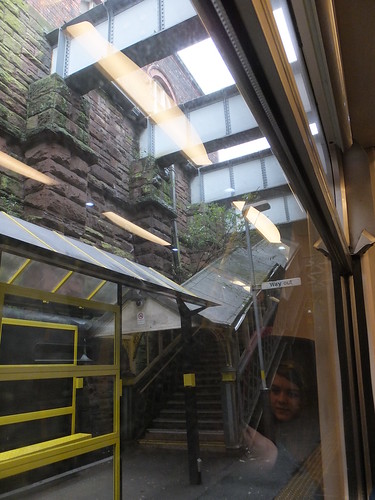Over the last few weeks, I've made a number of day trips by train, re-visiting locations I first went to half a century ago:-
Heysham and Morecambe (a seaport & a seaside resort - report here).Where next? Birkenhead and New Brighton (seaport and seaside resort).
Fleetwood and Blackpool (former seaport & a resort - report here).
Holyhead (a seaport and sort of seaside resort - report starts here).
Passing through Chester on the recent Holyhead trip, I was reminded that (as far as I remember) I'd never actually travelled on the Chester to Birkenhead line - a surprising omission. Until Nationalisation, it was a joint L.M.S. - G.W.R. line, mainly 4-track so it should have appealed to me, with a passenger service through to Birkenhead (Woodside) and significant freight traffic. In the 1980s, I'd travelled between Birkenhead and Rock Ferry by third rail electric trains, when Rock Ferry was the limit of electrification in the Liverpool area, but I hadn't travelled the line from Rock Ferry through Hooton to Chester.
In the past, I've reached Birkenhead by travelling to Liverpool and then crossing the Mersey by train or ferry but, for this trip, I decided to go to Chester and (finally) see what remained of the former L.M.S. - G.W.R. line to Birkenhead.
By train to Birkenhead
On the 8th February 2014 I caught the 08:37 Virgin service to Edinburgh, travelling as far as Crewe. At Crewe, I changed to a 2-car diesel service to Chester. Chester is now part of the Merseyrail network, so I was able to purchase a 'Saveaway' 1-day ticket for my onward journey.
I can still remember my shock, some years ago, to find third rail electrics now working right through to Chester (the line to Chester was electrified in 1993). To me, Chester will always be remembered as the last refuge of marvellous L&NWR signal gantries and signal boxes (see the post L&NWR Signalling and the 'Bedstead'. Even after the Chester Power Box scheme had swept away the semaphore signals and mechanical signal boxes, running electric trains into Chester just seemed wrong to me. However, from a passenger point of view, integrating the line to Chester into the Merseyrail network has been a good development.
I made my way to platform 7b at Chester (the only electrified platform) to catch the next Liverpool train.
 Chester: Liverpool electric service about to depart on 25-Jan-2014.
Chester: Liverpool electric service about to depart on 25-Jan-2014.
The Class 507 and 508 3-car electrics on the line are around 35 years old, but they bound along in a game fashion between stations and I was surprised at how good the ride was. There are a number of stations on the way to Birkenhead:-
BacheI've only commented on some of these stations below.
Capenhurst
Hooton
Eastham Rake
Bromborough
Bromborough Rake
Spital
Port Sunlight
Bebington
Rock Ferry
Green Lane
Birkenhead Central
Hamilton Square
Capenhurst
We are soon passing Capenhurst - the location of the Uranium Enrichment Facility for the U.K. There's a very clear article on enrichment processes in Wikipedia here. The Capenhurst site was originally constructed as a Royal Ordnance Factory in 1940. In 1952 Uranium Enrichment for military purposes commenced here, followed by enrichment for use in power generation in 1962. Urenco UK currently use part of the site for uranium enrichment using centrifuges and this is expected to continue until at least 2050. Reported enrichment throughput in 2011 was 5,000 tSW/a (five thousand metric tons of separative work per annum). The remainder of the site was used for uranium enrichment using diffusion until 1982 and the Nuclear Decommissioning Authority are now responsible for decommissioning and cleaning up this part of the site - one of 17 sites in the U.K. for which the Nuclear Decommissioning Authority are responsible. A slightly less rosy picture is given on the website of Greater Manchester & District Campaign for Nuclear Disarmament.
Hooton
In its heyday, Hooton had six through platforms, one bay, a double-track branch to Ellesmere Port and a single-line branch to West Kirby. Hooton is still the junction for Ellesmere Port and it has two through platforms and a bay. Towards Chester, the present double track is on the formation of the old Fast Lines but, just south of the station, these tracks are slewed onto the formation of the old Slow Lines and they remain like that until Rock Ferry. Chester Power Signal Box has not long taken over control of the line to Hooton. Thereafter, the line is controlled from the Merseyrail Control Centre at Sandhills.
 Hooton: Looking towards Chester from bay platform 1, showing platform 2 & 3 lines slewed onto the formation of the old Fast Lines
in front of the recently-closed Hooton signal box.
Hooton: Looking towards Chester from bay platform 1, showing platform 2 & 3 lines slewed onto the formation of the old Fast Lines
in front of the recently-closed Hooton signal box.
Port Sunlight
William Lever (1851 - 1925) founded the Lever Brothers soap-making empire with his brother. Needing a site for expansion of their operation in Warrington, they acquired land on the Wirral in between the railway from Chester to Birkenhead and the River Mersey. In 1888 work commenced on a new factory and also a Model Village to house the workers. The development became Port Sunlight. Each block of houses had a separate architect, all heavily influenced by the Arts and Crafts Movement. There are 900 buildings now listed Grade II in Port Sunlight, which is also a Conservation Area. The adjacent railway station of Bebington is close to the Lady Lever Art Gallery.
Rock Ferry
In the past, Rock Ferry was an important and impressive location. The four tracks of the L.M.S. - G.W.R. joint lines to Birkenhead were joined by the Mersey Railway (more in my post here) which terminated in a pair of bay platforms. There was some pointwork interconnecting the two systems. In the 1980s, I'd travelled between Birkenhead and Rock Ferry by third rail electric trains, when Rock Ferry was the limit of electrification in the Liverpool area. By that time, the Chester - Birkenhead line had been divided at Rock Ferry so that it operated as two back-to-back termini with electric trains operating to Birkenhead and Liverpool whilst Diesel Multiple Units worked to Chester.
Today, the former Fast lines are lifted and overgrown and the present double track (former Slow lines) are slewed into the Mersey Lines so that my train continued to Green Lane, Birkenhead Central and Hamilton Square on what was the Mersey Railway.

Rock Ferry, showing the construction of the platform canopy and the neat brick and stone waiting room. The bay platforms are visible in the background.
Green Lane
Green Lane station is set between two tunnels, constructed as an open 'box'. The vertical sides of the 'box' are held in place by stone-built walls, while a series of plate girders brace the stone walls apart at ground level.

Green Lane, showing stone retaining walls and girder bracing.
Hamilton Square
The Rock Ferry line platforms at Hamilton Square are deep underground and set on a curve. Originally, there was a 'flat' double junction at the Rock Ferry end of the station, for the connection to the Wirral Railway. In the 1970s, to avoid congestion at this junction, a third platform was added for trains towards West Kirby and New Brighton. This platform is in a separate, straight bore at a slightly lower level than the original two platforms. The new line continues to fall so as to pass under the lines from Rock Ferry in a 'burrowing junction'. I got off, watched my train disappear into the tunnel leading to Liverpool and then climbed the steps to the lower concourse. From here, a series of lifts take passengers to the 'Booking Hall Level' on the surface.
 Hamilton Square: View from platform 2, looking towards Rock Ferry.
Hamilton Square: View from platform 2, looking towards Rock Ferry.
Continued in Part 2.
Related articles on other sites
'Railscot' Chester and Holyhead.
Related posts in this blog
Birkenhead and New Brighton by train (Part 2)
Birkenhead and New Brighton by train (Part 3)
My pictures
North Wales Line (Crewe - Llandudno).
Merseyrail.
